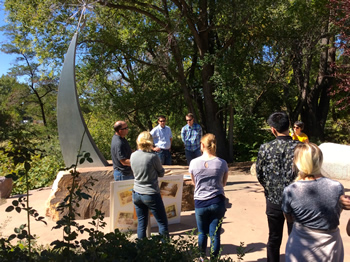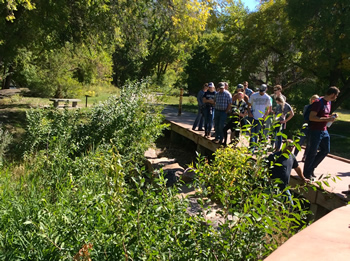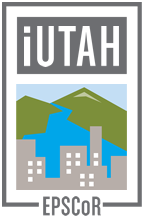Education and Outreach News
April 6, 2018
Outdoor Learning Reaches a Larger Classroom
The benefits of outdoor learning have been in the news for the past few years. Studies have found that going outdoors to learn science connects students and teachers to the natural environment. It reaches these students in new and different ways and gives them real world examples of what they are learning about in their classrooms.
Given the aim of the iUTAH project to engage and build a water-wise citizenry, it seemed only fitting that the project partnered with the Natural History Museum of Utah’s Taking Learning Outdoors (TLO) program. Over the six years that the TLO program was active in Utah schools, it was able to equip 98 K-12 teachers with resources, information, and professional insight that has helped them bring their local watershed into their classrooms.
Supported by iUTAH and facilitated by NHMU, teachers in TLO cohorts participated in a year-long series of workshops led by science and education experts from around Utah. Teachers examined their local watershed and learned how to most effectively incorporate these natural science into their curriculum. These teachers then brought what they learned into their classrooms, helping the program to reach over 12,000 students. When asked about their experience, one teacher said, “I feel that my confidence has increased as a result of realizing that science is all about using observations to describe and define our natural environment. Observations cannot be wrong. They can become more specific, defined and refined over time but they aren’t wrong. This helped me to be less afraid of science and love it more.”
A lasting legacy of the TLO program is the curriculum and insights available on NHMU’s website. Now, these lessons have been made available to encourage teachers to continue to take their classes outside by providing resources and lesson plans to help teachers feel more comfortable teaching outdoors. These lessons even include resources developed by Nancy Bo Flood, the author of Water Runs Through This Book, a book supported by iUTAH and given to many libraries, schools, and students throughout the state.
While the TLO program has ended its formal teaching program, banners now hang in 50 schools across the state that participated in the program. These banners encourage use of the lessons developed over the past five years. They also remind TLO teachers to share what they learned, helping their students to take an active interest in their watershed in a multi-disciplinary way.
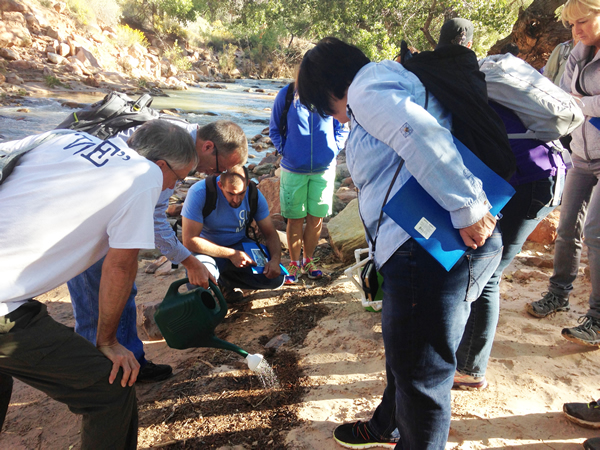
March 15, 2018
Citizen Science Project to Improve Utah Lake
iUTAH researcher Erin Jones helped lead a citizen water sampling effort to study and assess rivers and streams that lead into Utah Lake. Aimed at identifying the source of pollutants, this first project involved roughly 150 participants on March 10.
Jones, a teaching assistant for the participating Watershed Ecology class at Brigham Young University, said that around two-thirds of the people involved had contributed to a scientific study before this one. Of the people she talked to, most had some connection to water resources or just a general concern about the environment in general and Utah Lake specifically.
“I think one of my favorite parts about talking with people as they came to pick up their sampling materials or return their filled bottles was to hear about their connection to the watershed,” said Jones. “Many were sampling areas that they were familiar with, but hadn't necessarily ever stopped to think about the water quality there. Other people signed up to go somewhere in the watershed they had never been before, giving them a much deeper connection to place.”
Additional information on the sampling project came from reporter Auburn Remington in a March 7 article in Brigham Young University’s The Daily Universe. “BYU professor Ben Abbott, an ecosystem ecologist and the project director, said the project is focused on sampling by rivers and streams that lead into Utah Lake because they are ‘sensors of ecosystem health. Sampling many places in the river network gives you a high-resolution image, like a computer or a phone screen. If you have more points, you can see more clearly what is going on in a system,’ Abbott said. ‘What’s neat about a river is that it’s a natural organization, and the river has created this tree-like form that extends out into the landscape, and then if we listen to the river or analyze the chemistry of the river, it can tell us what’s happening.’
Abbott said the goal of the project is to identify the non-point sources of nutrients to Utah Lake, or in other words, the nutrients flowing into the lake from things other than pipes. Non-point nutrients include things that flow through the soil, such as fertilizer or contaminated storm water. ‘The other purpose of the study is to get people connected to their watershed, so we appreciate and value what we understand and know,’ Abbott said. ‘If people spend time around Utah Lake and in the rivers flowing to Utah Lake, they’ll realize that this isn’t a trashed or destroyed ecosystem, it’s a beautiful and vibrant environment.’ “
Jones said of those who participated, it would “hopefully increase their awareness and concern about local environmental issues.” The research group hopes to have another event in summer and another class at BYU in the fall to measure seasonal changes in factors such as nutrients. She invites people interested in attending future citizen science samplings of Utah Lake to visit the Utah Lake Research Collaborative website.
Press: The Daily Universe
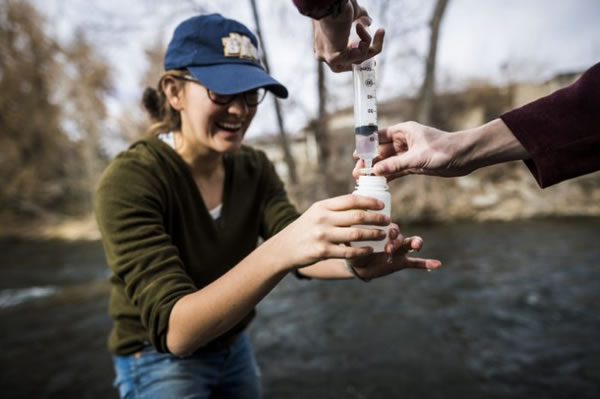
March 14, 2018
USU's Nancy Huntly Named Ecological Society of America Fellow
iUTAH researcher Nancy Huntly, professor and director of the Ecology Center at Utah State University, have been named a Fellow of the Ecological Society of America. She will be one of 28 honorees formally recognized by the ESA, the world’s largest community of professional ecologists.
A media release provided by USU’s science writer Mary-Ann Muffoletto said that the “ESA lauded Huntly’s ‘foundational research on herbivory, coexistence and human ecology,’ as well as her commitment to and innovation in both science communication and the application of ecological principles to the management of natural resources.
‘Nancy is an outstanding scientist, professor and administrator,’ says Maura Hagan, dean of USU’s College of Science. ‘Her contributions to the establishment and leadership of the USU Climate Adaptation Science program epitomize her innovations in science communication, as well as her scholarly research achievements. Nancy is an exceptional role model to her students and to the young faculty she mentors.’ “
Additionally, “Throughout her career, Huntly has been a key advocate for students and faculty from underrepresented groups. She’s a major contributor of the NSF-funded iUTAH project’s education, outreach and diversity efforts in areas of workforce development and diversity. Huntly also assisted with the establishment of a USU student chapter of SACNAS, the Society for Advancement of Hispanics/Chicanos and Native Americans in Science.
As chair of Science Unwrapped, Huntly oversees a six-person committee and dozens of volunteers, who present community-wide science outreach events, which draw some 500 attendees, ranging in age from preschoolers to senior citizens, to USU’s campus each month during the academic year.”
Press: USU Today | The Herald Journal | Deseret News

February 14, 2018
Traineeship Students Gain Real Skills
There are many internship opportunities for students at all levels found throughout the Utah educational system. iUTAH traineeships offered between 2013 and the present provided something different. “We knew we had students on the research-oriented campuses in the state that could benefit from gaining skills that were transferrable outside of academia,” said Ellen Eiriksson, iUTAH’s education, outreach, and diversity coordinator. The Traineeship Program is a workforce development initiative developed to provide students with skills that transfer beyond the academic realm, and that contribute to a strong Science, Technology, Engineering, and Math (STEM) trained workforce in Utah.
“Not all undergrads go on to higher degrees or careers in academia,” said Eiriksson. “Traineeships are meant to give students skills that they can take directly to the workforce with them.” Trainees were paired with faculty and other mentors on campuses to gain experience in their laboratories or other work settings. As undergraduates, trainees served as integral members of research teams, learning new skills, and even serving as near-peer mentors, passing those skills onto incoming trainees.
The average student was engaged with the program for one year, although this amount of time varied depending on research needs. Students benefited from a team environment, training alongside graduate students and other near-peer mentors. Below are some examples of the many interesting projects that they were involved in:
- Linking sensor networks to science through ecoinformatics
- Integrating data and models for hydrologic applications
- Exploring green roof food production and green infrastructure water use strategy
- Social science data management
- Quantifying precipitation effects from the Great Salt Lake
One former trainee, Phil Suiter, currently works as a civil engineer for Ogden City. He said that he “enjoyed working in the iUTAH trainee program because it opened my eyes to all the variety of work performed for research studies,” adding that the program “helped me learn the importance of the planning and preparation needed prior to field work which has helped me be more effective as I visit my infrastructure improvement sites.”
Another trainee, Natasha Griffin, worked on the GAMUT project in the Provo River, which she says "helped me to gain experience in doing fieldwork and collaborating with other researchers, which made me more confident about pursuing my own projects. I'm now working on two publications of my own as I finish my senior year, after which I'll head to graduate school in aquatic microbial ecology."
From a faculty perspective, mentors appreciated that the program was not limited to a summer session, so students were available for as long as they were needed. One mentor said “we enjoyed the consistency and enthusiasm that traineeships brought to the lab. The trainees always wanted to learn new skills and were always eager to help in the field and lab."
“As an iUTAH trainee I was responsible for installing, maintaining, calibrating and troubleshooting a wide variety of environmental sensors and equipment,” said Brett Boyer, trainee from 2015 – 2017. “I grew confident that with time and effort I could become an expert on a given piece of equipment and use my knowledge to solve any issues that might come up. I also worked on a challenging project developing a self-contained sensing and datalogging system that greatly increased my programming and troubleshooting experience.” These skills helped Boyer secure a position as a control systems engineer, working with heavy electrical equipment and programming controllers for a gold mining project in Mexico.
The iUTAH traineeship has involved 31 students to-date, many of whom are now employed in water-related technical fields, or continued their educations in graduate school both in Utah and neighboring states. These students benefited from access to iUTAH's diverse range of research and cross-institutional collaboration.
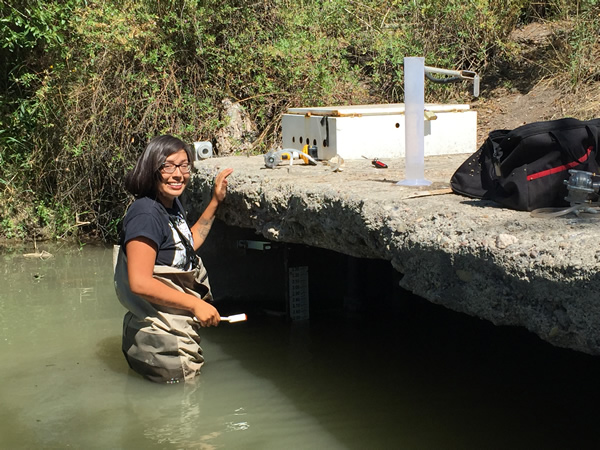
January 17, 2018
Cross-Campus Collaborations Bring Classrooms Together
One of the hallmarks of the iUTAH project has been collaboration between campuses across the state. Throughout the past five years, researchers have shared ideas, equipment, and even students. This spirit of sharing has led to the development of a number of cross-institutional courses, including ones involving hydroinformatics, watershed planning and management, and green infrastructure.
The Green Infrastructure course was co-taught for the second time around this last fall at Utah State University and the University of Utah. Ryan Dupont, a professor in civil and environmental engineering at USU, had 14 students in his section of the course, while Sarah Hinners, a research assistant professor in city and metropolitan planning at UU, had 12 students, or a total of 26 students.
The class met on Friday afternoons, at their own respective campuses in technology-linked classrooms, exploring the topic of green infrastructure from planning and engineering to homelessness and social equity, and hearing from a variety of guest speakers. Field trips brought the class together to meet in-person to view and discuss local examples of Green Infrastructure planning and execution in the Ogden area. They also ran parallel field trips in Logan and Salt Lake City, and reported back to one another.
When asked about the benefits of bring the course together, Ryan Dupont said that “content and discussions we have had in the joint offering course are richer, than when I am able to offer the course myself with only engineering students making up the class roster. I find it very valuable to have students, faculty and guest lecturers with different perspectives on this subject presenting and discussion issues on GI design and implementation.”
As part of the USU section, students completed a class project to enter EPA's Campus RainWorks Challenge, for which student teams design an innovative green infrastructure project for their campus that effectively manages stormwater pollution while benefitting the campus community and the environment. At UU, four students worked with the Jordan River Commission and a state legislator to produce background research and recommendations for a proposed Jordan River State Park.
Both Dupont and Hinners said that interdisciplinary engagement has been a very positive aspect of their involvement in iUTAH, one that they hope continues into the future. “I don’t have an available co-instructor from engineering down here, and I really can’t cover that topic area well myself, but it’s critical to the topic of green infrastructure,” said Hinners. “I really love having a diversity of backgrounds, experience and expertise in the classroom.”
Other courses brought together by the iUTAH project that use this model of cross-campus collaboration include Integrated River Basin Watershed Planning and Management and Water Resources Planning taught by David Roseberg from USU and Steven Burian from UU. In 2012, a Hydroinformatics graduate course was started taught by Jeff Horsburgh and David Rosenberg from USU, along with Steve Burian from UU, and Dan Ames from BYU. The course was offered simultaneously at the three locations via interactive video conferencing and covered information on how to use computer software and hardware to collect, manage, and analyze large amounts of water-related data. The course has been offered annually since 2012, with a one-time expansion in 2014 to include faculty and students from University of Wyoming, and University of Virginia.
Syllabi for the Fall 2017 Green Infrastructure course:
